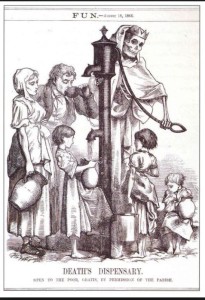Sufferers’ Land
Cholera Strikes Again
by Dave Barton
The summer of 1849, Cholera struck a second devastating blow across the Firelands. Sandusky, being the largest town in the region, was again the hardest hit. Over a period of sixty-eight days, three-hundred-and-fifty-eight people died out of a population of two-thousand-three-hundred. Thirty-three people died on Monday, July 30, the worst day of the epidemic. [1]

“Death’s Dispensary,” a cartoon by George Pinwell in FUN Magazine, August 18, 1866
In a letter dated July 19, a woman by the name of Priscilla Smith informed her sister that their father had died from the disease. Duty calls me to perform the painful task of informing you that our dear father is no more. He breathed his last at 12:00 o’clock tonight. We did not consider him dangerous until about three o’clock this afternoon when he grew very sick from being thrown into the last stages of the cholera. [2]
By this time, Norwalk had sufficient population density for the disease to take hold and spread. Soon the streets of the village were silent except for the rumble of wagons carrying the dead to their graves.
All summer and into the fall, the disease continued to terrorize the village. It finally ended with the first frost, and the survivors returned to their homes, wondering if it would reappear the following year.
Footnotes:
[1] History of the 1849 Cholera outbreak in Sandusky is from The Firelands Pioneer, July 1878, pp. 26-27.
[2] Letter from Priscilla Smith to her sister is from The Firelands Pioneer, New Series, Volume XXIII; April 1925; p. 327.
#
This post was first published on this blog in 2009.
#
Previous Post: Life in Norwalk, Ohio in the 1840’s
Next Post: The Benedict Family in the 1850’s
#
Thanks for visiting! Share and like this post below, and on Facebook. Let me know what you think in the comments. I’d love to hear from you!
Filed under: Cholera, Norwalk, Ohio, Ohio, Sandusky ohio, Uncategorized | Tagged: Cholera, Cholera 1849 1854, Firelands History, Norwalk Ohio History, Sandusky Ohio History, Sufferers' Land History | 12 Comments »

